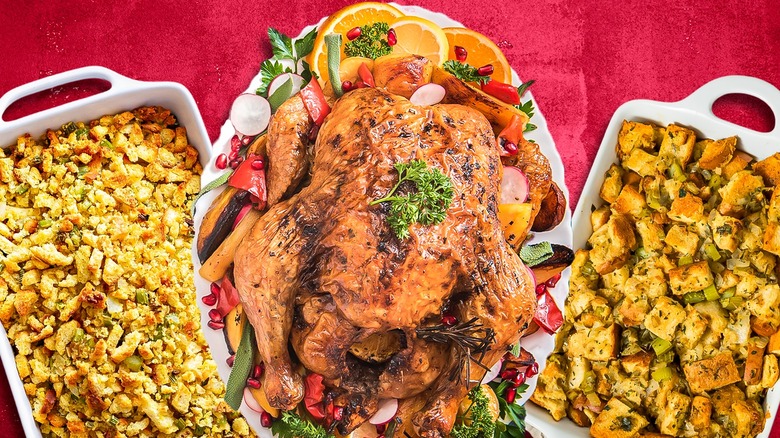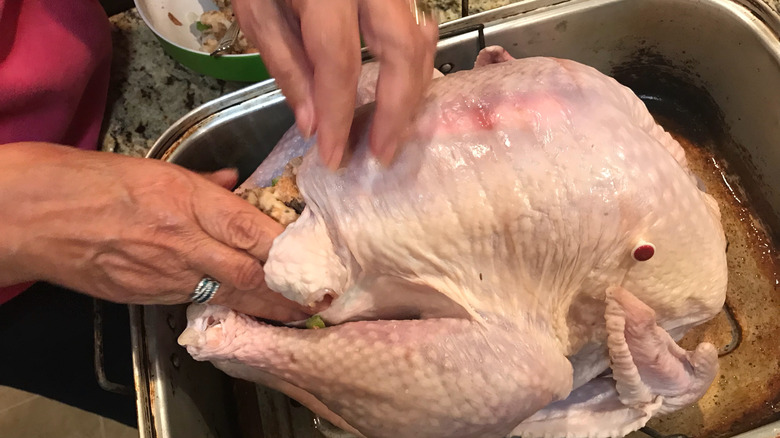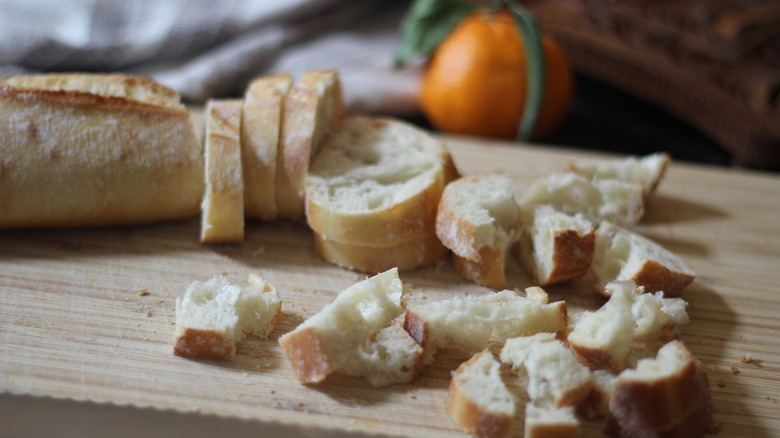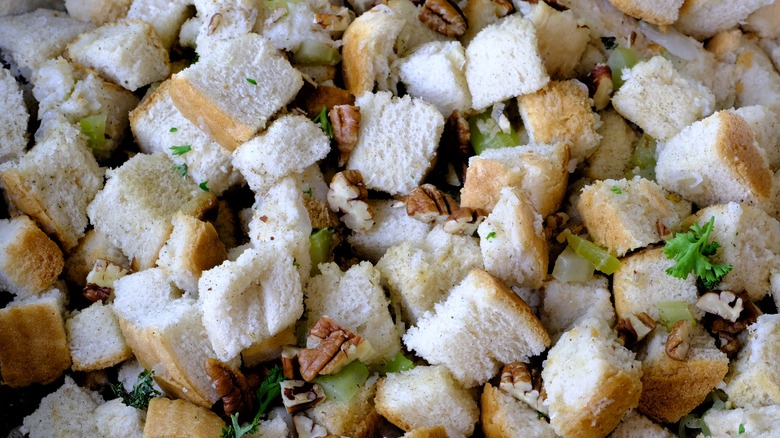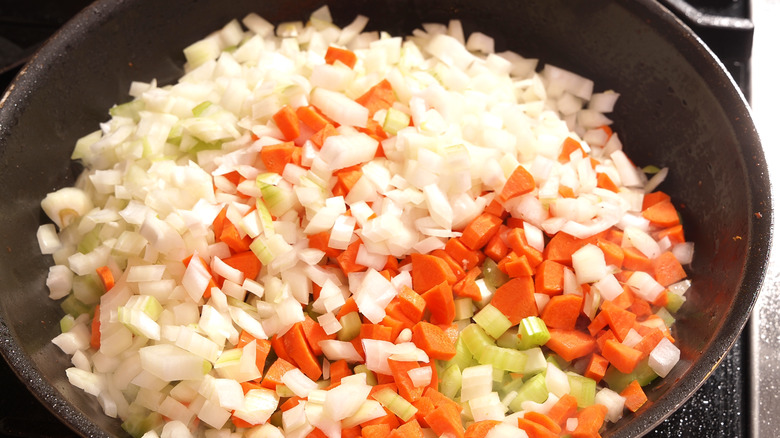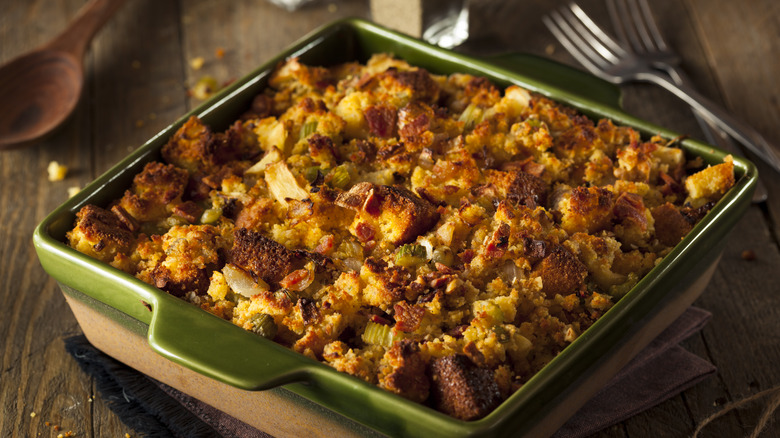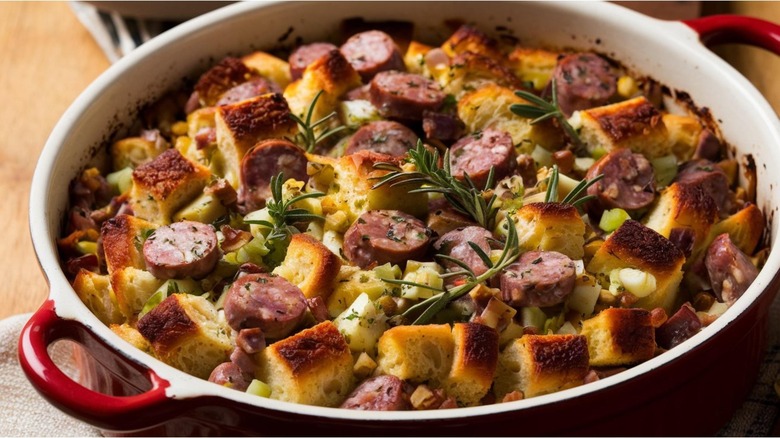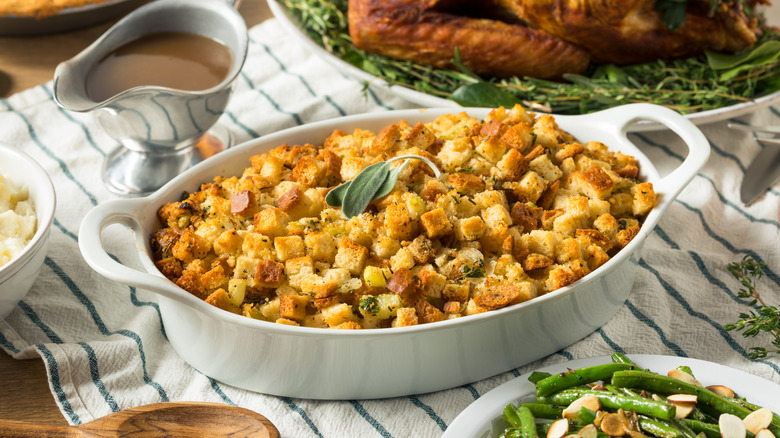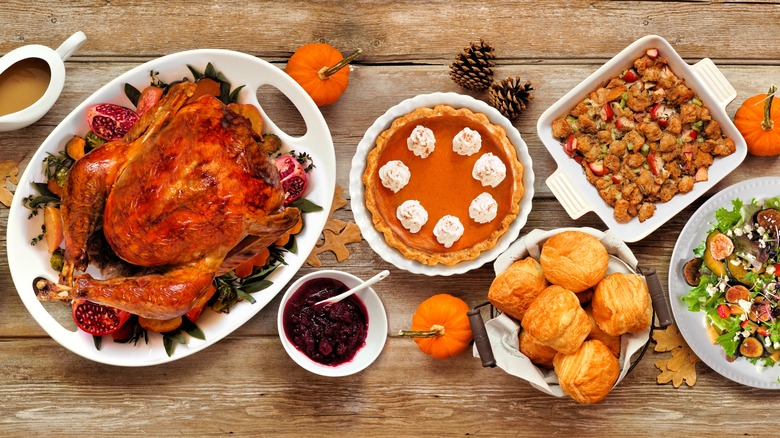8 Mistakes Everyone Makes When Cooking Stuffing
As the holiday season rolls around there are a few Thanksgiving staples you can always count on having to make at least once. Because from the turkey and the gravy, to the cranberry sauce and stuffing, there are some dishes that no Thanksgiving dinner is complete without. Whether you're a traditionalist who loves classic bread stuffing or an adventurous eater who tries new yearly add-ins like sausage, nuts, or more, making stuffing can be tricky.
It may be a holiday tradition today, but the the earliest recorded stuffing recipe was found in a Roman cookbook way back in the first century A.D. It consisted of spelt mixed with vegetables, herbs, and spices and was stuffed into animals before they were cooked. Though there's no evidence that stuffing was served at America's first Thanksgiving, the dish has evolved into an annual holiday tradition.
As a personal chef, I prepared all kinds of stuffing for my clients' holiday dinners. From cornbread stuffing to a Tuscan Bread Stuffing with cranberries and chestnuts, and everything in between, I've learned all the tips and tricks to make it moist and delicious. From texture to seasoning, there are several common mistakes that can take your stuffing from sensational to sad. Avoiding these stuffing slip ups is easy if you know what to look for. These tips will show you exactly what to steer clear of for perfect stuffing every time.
8. Stuffing it inside the turkey
A beautifully browned turkey filled with stuffing is the picture perfect centerpiece that likely comes to mind when you think of Thanksgiving dinner, but cooking the stuffing inside the turkey can be risky. Tradition aside, when it's cooked inside the bird, stuffing often doesn't reach the temperature that is necessary to kill any bacteria that might be present.
In order to cook the bird long enough to get the stuffing inside to a safe temperature, you'd have to cook the turkey until it reaches temperatures between 180 and 190 degrees Fahrenheit, which is well past the USDA's recommendation of 165 degrees Fahrenheit. The result will likely be turkey meat that is overcooked, grainy, and dry, not the moist, tender turkey of your holiday dreams.
To keep things safe, cook your stuffing separately in its own baking dish, which technically makes it dressing. The difference between stuffing vs dressing is simple. They're made of the same ingredients and the only distinction between the two is where they're cooked. As its name implies, stuffing is cooked inside the bird and dressing is baked on its own in another pan or baking dish.
7. Using fresh bread
Fresh bread has many delicious uses. It's an excellent choice for sandwiches and for enjoying on its own with a generous slather of butter, especially if it's warm from the oven. Some have even made the case for trying fresh bread in your panzanella salads, but as useful as it might be in many recipes, fresh bread is not the best choice when you're making stuffing from scratch.
One of the reasons we love fresh bread is because of its soft texture. For stuffing you need a bread that can maintain its texture and shape once other ingredients are added, especially the chicken stock or whatever your cooking liquid of choice is. Fresh bread will absorb the cooking liquid and either fall apart or dissolve altogether. Stuffing made with fresh bread will be soggy at best, without the crisp top and tender center we love.
If you only have fresh bread on hand, you can toast it to dry it out so you can use it immediately. Cut or tear your fresh bread into cubes, toss them onto a baking sheet and bake them until they are golden brown. Be sure to arrange them in one even layer. If they're piled on top of each other they won't toast or brown evenly.
6. Getting the ratios wrong
Perfect stuffing is a delicious blend of textures and tastes. The crispy, golden brown top is the perfect counterbalance to the soft, moist center. Too much liquid and your stuffing will bake up soggy, no crispy surface in sight. Too little liquid and you'll end up with a pan of hard, dry bread and vegetables. Include too many add-ins and your stuffing will likely fall apart when served; too little won't add enough flavor to the bread. Fortunately, it is possible to avoid these stuffing mishaps. The best way to ensure the perfect texture for stuffing is to get your ingredient ratios right.
The best formula for making stuffing starts with making sure the bread is the star of the show. Your stuffing should have more bread than anything else. When it comes to other ingredients — veggies, grains, meat or seafood — they should equal about half the amount of bread you're using. As for your cooking liquid, stick with one cup of broth or stock for every four cups of bread you're working with. With these ratios as you guide you should be able to produce perfect stuffing every time.
5. Skipping the sauté
Baking your stuffing or preparing it on your stovetop, it's crucial that you sauté your veggies until they're soft. You might be tempted to save a little time by mixing your vegetables in and relying solely on the oven to cook them fully, but you'll regret it. If you've ever eaten stuffing where the crunch came not from the crispy bread, but from a grossly undercooked bit of carrot or celery, it's likely the result of the cook not sautéing the vegetables before adding them to the stuffing to bake.
If you're using vegetables with different cooking times, consider using the ground up method of sautéing. Start with your veggies that grow underground, like carrots and potatoes, then once they've begun to soften you can add those that grow above ground, which typically require less cooking time. The goal is to make sure the vegetables and any meats you're adding are fully cooked before you add them to the stuffing to bake.
Although its not exclusive to stuffing, make sure you avoid the mistakes everyone makes when sautéing, like overcrowding the pan or using a pan that's too small. The goal is vegetables that are tender, but not too brown. You can add herbs and spices at the end for additional flavor.
4. Adding the liquid all at once
Unlike baking, cooking is not always an exact science. Making stuffing from scratch is an excellent example of this theory, especially when it comes to adding the perfect amount of liquid to your recipe. It's very easy to add too much liquid, even if it's the exact amount your recipe calls for. Factors like the type of bread you're using, how fresh or dry it is, and how many and what other ingredients you're adding to your stuffing can affect how much liquid is required to achieve the perfect consistency. For best results, avoid adding all of your liquid at once.
Pouring all of your liquid in at once can lead to oversaturated bread and a soggy stuffing. You want the bread to absorb the liquid and adding it all at once can lead to your sturdy, dry bread sitting in a puddle. To protect the texture of the bread and your stuffing, add the liquid gradually. Start with ½ cup to one cup at a time then wait until it's absorbed before adding more. This may add a few minutes on to your time in the kitchen, but exercising a little patience will save you from soggy stuffing.
3. Getting the amount wrong
There might be no greater Thanksgiving nightmare than running out of food, especially the all-star recipes like turkey and stuffing. It can be difficult determining the right amount of food to make for Turkey Day. You want enough for everyone to get their fill, even any unexpected guests who show up, and maybe have some leftovers, but not so much that you're stuck eating Thanksgiving dinner on repeat for days at a time. On the other hand, if you don't make enough of each dish you'll face a table full of disappointed family and friends.
When it comes to turkey, the guidelines on how many pounds of turkey per person are clear, but deciding how much stuffing to prepare can be a bit more challenging. You can avoid not getting the amount of stuffing right by planning on about ¾ cups of stuffing per guest, about 4½ cups of stuffing for six guests. If you want to enjoy leftovers, make another 1½ cups of stuffing for every six guests you're serving.
2. Not getting the cooking time right
Thanksgiving is not the time for preventable cooking mistakes, like not getting the cooking time right for your stuffing. Like the turkey and all of your pies, cooking each dish for precisely the right amount of time is integral to a delicious and properly-cooked result. If you botch the cooking time your overcooked stuffing will bake up dry and grain. Don't cook it long enough and you'll have soggy and potentially dangerous stuffing. For perfect stuffing that's crispy, moist, and bacteria-free, you'll need more than a kitchen time to get it right.
Any good stuffing recipe will give you an amount of time to cook your stuffing in addition to other signs that will help you determine when your stuffing is fully cooked. It's imperative that your stuffing reaches 165 degrees Fahrenheit if you're cooking it inside the bird, but you also need to make sure it reaches that temperature if you're cooking it on its own in a separate dish and have added raw eggs to it. To ensure the top of your stuffing is crisp, remove the lid in the last 10 minutes of cooking so it's exposed to direct heat from your oven. These few minutes will produce a crunchy surface without worries about drying the stuffing out. If you're taking your stuffing on the road, undercook it slightly so you don't overcook it when you reheat it at your destination.
1. Making it the day of
There is no more prized real estate than the inside of an oven on Thanksgiving Day. Dishes are all vying for available oven racks, making it difficult to serve a meal where every dish is hot. You can save yourself the headache of trying to cram all of your dishes into your oven on the big day by making your stuffing ahead of time. You might be worried that stuffing made in advance won't taste the same as its day-of counterpart, but it might actually improve its flavor.
Most stuffing recipes are perfect for making ahead. You can assemble most ahead without sacrificing taste or texture. Making it ahead also gives the flavors more time to blend, resulting in a more delicious stuffing. To save time on the big day, assemble your stuffing up to three days before you need it. Store it in an airtight container in the fridge and pop it into the oven for the first round of baking the day before the holiday.
Cover it with foil during this first bake. This will cook the inside fully without drying out the surface. On Thanksgiving morning, remove it from the oven and bake it again without the foil so the top can crisp. You'll need much less time in the oven since the stuffing is already fully cooked. In fact, you should be able to complete this step once you've removed the turkey from the oven and are resting it.
